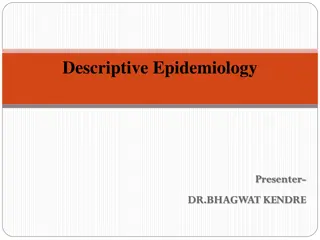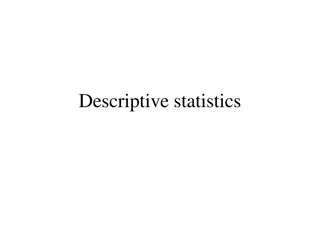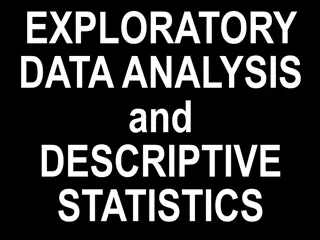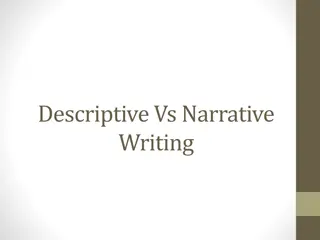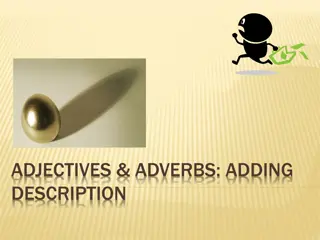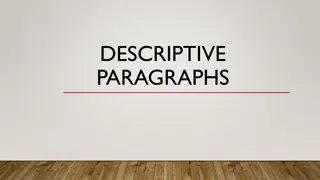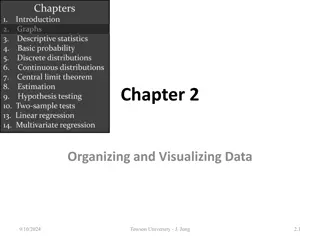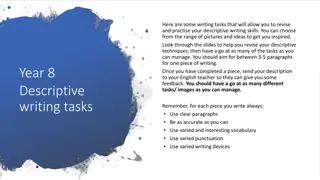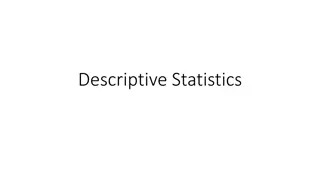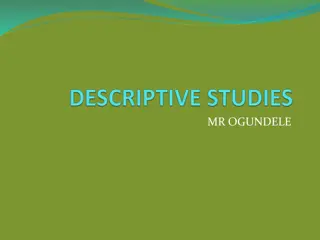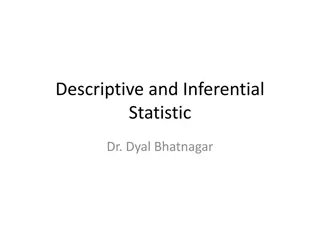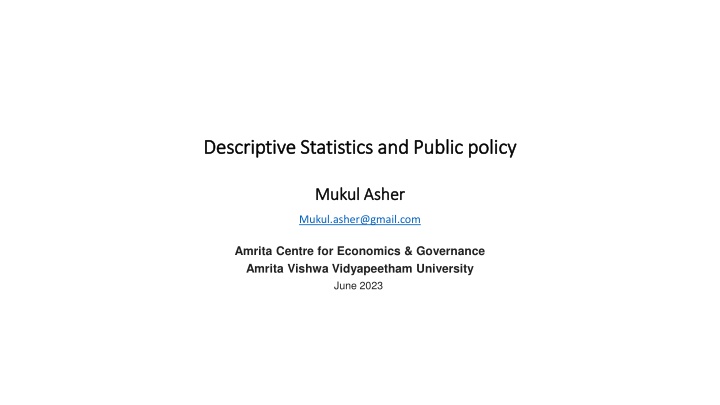
Descriptive Statistics in Public Policy and the Impact of C.R. Rao's Work
Explore the intersection of descriptive statistics and public policy through insightful discussions on influential figures like C.R. Rao. Learn about the significance of Rao's contributions to statistical thinking and their application across various disciplines, from information geometry to artificial intelligence. Discover how foundational results like the Cramer-Rao lower bound and the Rao-Blackwell Theorem have revolutionized statistical methods and continue to shape modern data analysis practices.
Download Presentation

Please find below an Image/Link to download the presentation.
The content on the website is provided AS IS for your information and personal use only. It may not be sold, licensed, or shared on other websites without obtaining consent from the author. If you encounter any issues during the download, it is possible that the publisher has removed the file from their server.
You are allowed to download the files provided on this website for personal or commercial use, subject to the condition that they are used lawfully. All files are the property of their respective owners.
The content on the website is provided AS IS for your information and personal use only. It may not be sold, licensed, or shared on other websites without obtaining consent from the author.
E N D
Presentation Transcript
Descriptive Statistics and Public policy Descriptive Statistics and Public policy Mukul Asher Mukul Asher Mukul.asher@gmail.com Amrita Centre for Economics & Governance Amrita Vishwa Vidyapeetham University June 2023
Organization Organization Preliminaries Lessons from Darrel Huff s 1954 Book-How to Lie with Statistics Select Examples from India
Preliminaries Preliminaries C. R. Rao C. R. Rao https://www.republicworld.com/world-news/global-event-news/indian-american- mathematician-cr-rao-aged-102-awarded-international-prize-in-statistics-articleshow.html Accessed on April 10,2023 Calyampudi Radhakrishna Rao, a prominent Indian-American mathematician and statistician, will receive the 2023 International Prize in Statistics, the equivalent to the Nobel Prize in the field, for his monumental work 75 years ago that revolutionised statistical thinking. Rao's work, more than 75 years ago, continues to exert a profound influence on science, the International Prize in Statistics Foundation said in a statement. In awarding this prize, we celebrate the monumental work by C R Rao that not only revolutionized statistical thinking in its time but also continues to exert enormous influence on human understanding of science across a wide spectrum of disciplines, said Guy Nason, chair of the International Prize in Statistics Foundation. In his remarkable 1945 paper published in the Bulletin of the Calcutta Mathematical Society, Rao demonstrated three fundamental results that paved the way for the modern field of statistics and provided statistical tools heavily used in science today, the Foundation said in a statement on April 1.
Preliminaries Preliminaries C. R. Rao C. R. Rao The first, now known as the Cramer-Rao lower bound, provides a means for knowing when a method for estimating a quantity is as good as any method can be, it said. The second result, named the Rao-Blackwell Theorem (because it was discovered independently by eminent statistician David Blackwell), provides a means for transforming an estimate into a better in fact, an optimal estimate. Together, these results form a foundation on which much of statistics is built, the statement said. And the third result provided insights that pioneered a new interdisciplinary field that has flourished as information geometry. Combined, these results help scientists more efficiently extract information from data, the statement added.
Preliminaries Preliminaries C. R. Rao Information geometry has recently been used to aid the understanding and optimization of Higgs boson measurements at the Large Hadron Collider, the world s largest and most powerful particle accelerator. It has also found applications in recent research on radars and antennas and contributed significantly to advancements in artificial intelligence, data science, signal processing, shape classification, and image segregation. The Rao-Blackwell process has been applied to stereology, particle filtering, and computational econometrics, among others, while the Cramer-Rao lower bound is of great importance in such diverse fields as signal processing, spectroscopy, radar systems, multiple image radiography, risk analysis, and quantum physics. Rao was born to a Telugu family in Hadagali, Karnataka. His schooling was completed in Gudur, Nuzvid, Nandigama, and Visakhapatnam, all in Andhra Pradesh.
Preliminaries Preliminaries Data has some public good characteristics. Once produced, marginal cost of additional person using it is very low. High average cost, low marginal cost. But those who do not pay, can be excluded. It is for this reason that essential socio-economic and other data is produced by the government, to be made available with no cost or minimal cost to the user. In a feedback loop based policy-making system good and timely data are critical.
The idea that data is the new oil has to do with the similarities in how the two resources become valuable. Just like oil, raw data isn't valuable in and of itself; rather, the value is created when it is gathered quickly, completely, and accurately, and connected to other relevant data. Data in the 21st Century is like Oil in the 18th Century: an immensely, untapped valuable asset. Like oil, for those who see Data s fundamental value and learn to extract and use it there will be huge rewards. We re in a digital economy where data is more valuable than ever. It s the key to the smooth functionality of everything from the government to local companies. Without it, progress would halt. https://www.wired.com/insights/2014/07/data-new-oil-digital-economy/ Accessed on 10 April 2023 Adding value to data requires adherence to the spirit of the scientific method Next Slide
#PublicEcon, #RegulatoryEc How many ministries, departments, agencies, central or state, know how to do #cost-#benefit #analysis that informs whether & how to regulate, and/or how to allocate public investment? My guess 0 to 10, in whole of India Arvind Virmani, Member, NITI Aayog This suggests plenty of scope for capacity building in Monitoring and Evaluation
Steward Brand Interesting: how much bad news is anecdotal and good news is statistical. (And how invisible the statistical is.) Still, if only one of the two can be good news, I would rather it be the statistical. It accumulates toward qualitative change that lasts.
Lessons from Darrel Huffs 1954 Book Lessons from Darrel Huff s 1954 Book- -How to Lie with Statistics How to Lie with Statistics
Lessons from Darrel Huffs 1954 Book Lessons from Darrel Huff s 1954 Book- -How to Lie with Statistics How to Lie with Statistics These lessons are copied from : https://towardsdatascience.com/lessons-from-how-to-lie-with- statistics-57060c0d2f19 By Will Koehrsen Accessed on 10 April 2023 The rest of the slides on the Lessons are words of Will Kohersen and not mine.
Lessons from Darrel Huffs 1954 Book Lessons from Darrel Huff s 1954 Book- -How to Lie with Statistics How to Lie with Statistics How to Lie With Statistics is a 65-year-old book that can be read in an hour and will teach you more practical information you can use every day than any book on big data or deep learning. For all promised by machine learning and petabyte-scale data, the most effective techniques in data science are still small tables, graphs, or even a single number that summarize a situation and help us or our bosses make a decision informed by data. As producers of tables and graphs, we need to effectively present valid summaries. As consumers of information, we need to spot misleading/exaggerated statistics which manipulate us to take action that benefits someone else at our expense. These skills fall under a category called data literacy : the ability to read, understand, argue with, and make decisions from information. Compared to algorithms or big data processing, data literacy may not seem exciting, but it should form the basis for any data science education.
Lessons from Darrel Huffs 1954 Book Lessons from Darrel Huff s 1954 Book- -How to Lie with Statistics How to Lie with Statistics 1. View Correlations with Skepticism When two variables X and Y are correlated meaning they increase together, decrease together, or one goes up as the other does down there are four possible explanations: A. X causes Y B. Y causes X C. A 3rd variable, Z, affects both X and Y D. X and Y are completely unrelated We often immediately jump to or are led to believe A or B when C or D may be as likely. For example, when we hear that more years of college education is positively correlated with a higher income, we conclude that additional years of university lead to greater wealth. However, it could also be a 3rd factor, such as willingness to work hard or parental income, is behind the increase in both more years of tertiary education and higher income. The 3rd hidden variable can lead us to incorrect conclusions about causality.
Other times two variables may appear to be correlated, but really have nothing to do with each other. If you make enough comparisons between datasets, you are bound to find some interesting relationships that look to move in sync. These are called Spurious Correlations.
Lessons from Darrel Huffs 1954 Book Lessons from Darrel Huff s 1954 Book- -How to Lie with Statistics How to Lie with Statistics
Lessons from Darrel Huffs 1954 Book Lessons from Darrel Huff s 1954 Book- -How to Lie with Statistics How to Lie with Statistics We ve all heard the advice that correlation does not imply causation, but even when there is a causal effect, it s often uncertain which way it goes. Does more praise of students from a teacher lead to higher grades? Do higher grades cause more praise? Or is there a third factor, smaller class sizes or more natural lighting in a class, causing both variables to increase? Questions of cause are answered by randomized controlled trials, not by observational studies where we cannot rule out additional factors that we do not measure. To avoid being misled, approach correlations between variables with skepticism by looking for confounding factors. Humans like neat, causal narratives, but that s usually not what the data is telling us.
Lessons from Darrel Huffs 1954 Book Lessons from Darrel Huff s 1954 Book- -How to Lie with Statistics How to Lie with Statistics 2. Relationships Don t Last Forever If you have successfully identified a correlation, don t assume it lasts forever in either the positive or negative direction. Linear relationships are almost always only linear in a limited region of both variables. Beyond a point, the relationship may become logarithmic, completely disappear, or even reverse. Extrapolating beyond the region of applicability for a relationship is known as a generalization error. You are taking a local phenomenon and trying to apply it globally. As people rise out of poverty, they tend to become more satisfied with life. However, once they hit a certain point (perhaps $75,000/year in the United States) happiness does not increase with wealth and may even decrease. This suggests there are diminishing returns to increasing wealth, just as there are in many aspects of human activity, like studying for a test.
Lessons from Darrel Huffs 1954 Book Lessons from Darrel Huff s 1954 Book- -How to Lie with Statistics How to Lie with Statistics We see extrapolations all the time: growth rates for companies, population demographics, prices of stocks, national spending, etc. Oftentimes, people will use a valid relationship in one region to make a point about a region off the chart (for example claiming that $1 million/year will bring pure bliss). Remember, relationships in a local area do not always apply globally. Even if you have verified a causal relationship or see one in a chart make sure you don t understand outside the limited region of validity.
Lessons from Darrel Huffs 1954 Book Lessons from Darrel Huff s 1954 Book- -How to Lie with Statistics How to Lie with Statistics 3. Always Look at the Axes on a Chart Adjusting the axes of a graph to make a point is a classic technique in manipulating charts. As a first principle, the y-axis on a bar chart should always start at 0. If not, it s easy to prove an argument by manipulating the range, by for example, turning minor increases into massive changes:
Lessons from Darrel Huffs 1954 Book Lessons from Darrel Huff s 1954 Book- -How to Lie with Statistics How to Lie with Statistics
Lessons from Darrel Huffs 1954 Book Lessons from Darrel Huff s 1954 Book- -How to Lie with Statistics How to Lie with Statistics Another example of misleading graphs is y-axes with different scales. By carefully adjusting values, you produce surprising trends where none exist.
Lessons from Darrel Huffs 1954 Book Lessons from Darrel Huff s 1954 Book- -How to Lie with Statistics How to Lie with Statistics
Lessons from Darrel Huffs 1954 Book Lessons from Darrel Huff s 1954 Book- -How to Lie with Statistics How to Lie with Statistics While this may seem like an obvious manipulation, advertisers and newspapers get away with it because people do not read information. Most people see a graph and immediately draw a conclusion from the shape of the lines or bars, exactly as the person who made the graph wants. To counter this, try reading axes values. A simple examination may tell you changes are not as big as they look and trends have been created from nothing! Once you get some practice making graphs, you realize how easy it is to manipulate them to your advantage. The best protection against inaccurate figures may be firsthand practice in making them yourself. (If you want a good book on making legitimate data visualizations, check out The Visual Display of Quantitative Information by Edward Tufte or Fundamentals of Data Visualization by Claus Wilke.)
Lessons from Darrel Huffs 1954 Book Lessons from Darrel Huff s 1954 Book- -How to Lie with Statistics How to Lie with Statistics 4. Small Samples Produce Shocking Statistics Would you be surprised if I told you the highest cancer rates tend to occur in the counties with the smallest populations? Not that shocking. How about when I add that the lowest cancer rates also tend to occur in counties with the lowest number of people? This a verified example of what occurs with small sample sizes: extreme values. Any time researchers conduct a study, they use what is called a sample: a subset of the population meant to represent the entire population. This might work fine when the sample is large enough and has the same distribution of the larger population, but often, because of limited funding or response rates, psychological, behavioral, and medical studies are conducted with small samples, leading to results that are questionable and cannot be reproduced.
Lessons from Darrel Huffs 1954 Book Lessons from Darrel Huff s 1954 Book- -How to Lie with Statistics How to Lie with Statistics Scientists are usually limited to small samples by legitimate problems, but advertisers use small numbers of participants in their favor by conducting many tiny studies, one of which will produce a positive result. Humans are not great at adjusting for sample sizes when evaluating a study which in practice means we treat the results of a 1000 person trial the same as a 10 person trial. This is known as insensitivity to sample size or sample size neglect .
Lessons from Darrel Huffs 1954 Book Lessons from Darrel Huff s 1954 Book- -How to Lie with Statistics How to Lie with Statistics Here s another example; if you consider yourself to be data literate, then you will have no problem with this question: A certain town is served by two hospitals. In the larger hospital, about 45 babies are born each day, and in the smaller hospital, about 15 babies are born each day. As you know, about 50% of all babies are boys. However, the exact percentage varies from day to day. Sometimes it may be higher than 50%, sometimes lower. For a period of 1 year, each hospital recorded the days on which more than 60% of the babies born were boys. Which hospital do you think recorded more such days? 1. The larger hospital 2. The smaller hospital 3. About the same (that is, within 5% of each other)
Lessons from Darrel Huffs 1954 Book Lessons from Darrel Huff s 1954 Book- -How to Lie with Statistics How to Lie with Statistics If you guessed 2., then congratulations, you are data literate! The reasoning is the smaller the sample size, the more extreme the values. (This is from Judgment under Uncertainty: Heuristics and Biases by Tversky and Kahnemann. I d highly recommend reading this paper and Thinking, Fast and Slow, to learn about cognitive biases that affect our decision-making.) You can test the principle that small samples produce extreme results by flipping a coin. With a small sample, say 5 tosses, there is a good chance you get 4 tails. Does this mean the coin always comes up 80% tails? No, this means your sample is too small to draw any significant conclusions.
Lessons from Darrel Huffs 1954 Book Lessons from Darrel Huff s 1954 Book- -How to Lie with Statistics How to Lie with Statistics This trick is often used when marketing products by asking a small number of people about a particular brand. You can get impressive-sounding numbers (90% of doctors like this toothpaste) if you repeatedly survey small groups and only report the favorable results. Ask a small group, look at the results, throw away the bad, and repeat until you get the stats you need! The solution to avoid being fooled by small sample sizes is to just look for the number of observations in the data. If not given, then assume whoever took the study has something to hide and the statistics are worthless. Behavioral scientists have shown that most of us are fallible to neglecting sample size; don t make the same mistake trust a large number of observations, not shocking statistics from small samples.
Lessons from Darrel Huffs 1954 Book Lessons from Darrel Huff s 1954 Book- -How to Lie with Statistics How to Lie with Statistics 5. Look at all the Numbers that Describe a Dataset Checking the sample size can be one way to avoid getting fooled by data, but only if the sample size is provided. Another trick used to mislead consumers of data is to avoid listing relevant numbers that describe a dataset, such as the count of observations, the spread of the data (range), the uncertainty about the data (standard error), the quantiles of the data, and so on. Each of these can be used to get a deeper dive into the data, which often goes against the interest of whoever presents the dataset. For instance, if you hear that the average (more on this below) temperature in a city is 62 degrees F for the year, that is not helpful without knowing the maximum and minimum. The city could get as cold as -20 F and as warm as 120 F but still average out to a comfortable value. In this case, as in many others, a single number is not adequate to describe a dataset.
Lessons from Darrel Huffs 1954 Book Lessons from Darrel Huff s 1954 Book- -How to Lie with Statistics How to Lie with Statistics As another example from the book, if you have two children, one of whom tests a 99 on IQ and the other a 102, you really should not tell them to avoid comparisons. Why? Because IQ tests can have a standard error of around 3 points which means a child scoring a 99 once would be expected to score between 96 and 102 about 68% of the time. The overall difference might not be significant and could reverse itself in repeated testing. In other words, by leaving out the expected standard error in the results, you can draw a more drastic conclusion than that offered by the data.
Lessons from Darrel Huffs 1954 Book Lessons from Darrel Huff s 1954 Book- -How to Lie with Statistics How to Lie with Statistics Studies that don t report more than one number usually have something to hide. Likewise, if a graph looks like it cuts off some of the data, it s not trustworthy. It s too easy to change a narrative by subsetting data.
Lessons from Darrel Huffs 1954 Book Lessons from Darrel Huff s 1954 Book- -How to Lie with Statistics How to Lie with Statistics
Lessons from Darrel Huffs 1954 Book Lessons from Darrel Huff s 1954 Book- -How to Lie with Statistics How to Lie with Statistics Think of it this way: if there was a medicine that increased lifespan by 2 years on average would you take it? Would it change your mind if the worst impact was a loss of 12 years of life and the maximum a gain of 14 years? It usually is the details that matter and one summary statistic cannot tell the whole story.
Lessons from Darrel Huffs 1954 Book Lessons from Darrel Huff s 1954 Book- -How to Lie with Statistics How to Lie with Statistics 6. Check which Average is Used Another useful way to tell whatever story you want with data is to vary the definition of average . You have 3 options (maybe more if you re clever): 1.Mean: sum the values and divide by the number of observations 2.Median: order the values from smallest to greatest and find the middle 3.Mode: find the value that occurs most often the mean and median of a distribution are the same only if it is normal and we live in a world with mostly non-normal data. This means the mean and median of a dataset are not the same value, often by a considerable amount.
Lessons from Darrel Huffs 1954 Book Lessons from Darrel Huff s 1954 Book- -How to Lie with Statistics How to Lie with Statistics
Lessons from Darrel Huffs 1954 Book Lessons from Darrel Huff s 1954 Book- -How to Lie with Statistics How to Lie with Statistics The way to avoid this is to look at the mean, median, and mode of a dataset (again you need all these numbers!). Figure out which one is most appropriate (usually the median for highly skewed datasets such as income, city size, life span, housing prices and so on) and use that if you need a one figure summary. If you can, graph the entire set of values in a histogram and look at the distribution. Try to use more than a single number to describe a dataset, and if you report an average, specify which you are using. See why more than one umber is needed in the next slide. Data are a decade old, but they make a point. Also see slide after the next on Indian data on child marriages
Child marriages are falling rapidly in India. Big variations in progress across states - while Uttar Pradesh has made remarkable gains (massive decline!), West Bengal continues to struggle with very high prevalence (42%) and minimal decline. ---Shamika Ravi
Lessons from Darrel Huffs 1954 Book Lessons from Darrel Huff s 1954 Book- -How to Lie with Statistics How to Lie with Statistics 7. Use Comparisons to a Common Baseline When viewing a statistic, the important question often is not what is the value, but how does the current value compare to the previous value? In other words, what is the relative change compared to the absolute magnitude. If I tell you the US GDP was $19.39 trillion in 2017, that sounds incredible because of your everyday experience. However, if you compare that to US GDP in the previous year, $18.62 trillion, it doesn t look nearly as impressive.
Data is often on scales with which we are unfamiliar, and we need a comparison to other numbers to know if a statistic represents a real change. Is a mean radius of 3389 km for Mars large? I have no conception of what that means until it s compared to other planets!
Lessons from Darrel Huffs 1954 Book Lessons from Darrel Huff s 1954 Book- -How to Lie with Statistics How to Lie with Statistics
Lessons from Darrel Huffs 1954 Book Lessons from Darrel Huff s 1954 Book- -How to Lie with Statistics How to Lie with Statistics Not only do we want to compare a statistic to values in the past and to numbers in the same category, but we also want to make sure the definition of the stat doesn t change. According to How to Lie , The number of farms in the US increased from 1930 to 1935 by 500,000 because the definition of a farm from the Census Bureau changed! The easiest way to lower unemployment is just to change the definition to exclude people who have stopped looking for work.
Lessons from Darrel Huffs 1954 Book Lessons from Darrel Huff s 1954 Book- -How to Lie with Statistics How to Lie with Statistics Changes in the way data is gathered or in the definition of values can often produce extreme results mistaken for actual trends. To counter this, first, look at the entire series of values for perspective. Second, make sure the definition has not changed over the time range. Only then can you start to draw conclusions from the data series. You can scare people by saying New York had 289 murders in 2018, but when you compare that to 2245 in 1990, you realize New York City has never been safer! It s usually the comparison that matters; don t let an isolated number sway your rational thinking.
Lessons from Darrel Huffs 1954 Book Lessons from Darrel Huff s 1954 Book- -How to Lie with Statistics Lie with Statistics How to 8. Look for Bias in Sample Selection Remember when we talked about all data being gathered from samples which we hope are representative of the population? In addition to being concerned about sample size, we also need to look for any bias in the sample. This could come from the measurement method used: a landline phone screen might favor wealthier, older participants. It could also come from the physical location: surveying only people who live in cities because it s cheaper might bias results toward more progressive views. Sample bias is particularly prevalent in political polling where 2016 showed that sometimes samples are not representative of an entire population.
Lessons from Darrel Huffs 1954 Book Lessons from Darrel Huff s 1954 Book- -How to Lie with Statistics How to Lie with Statistics When examining a study, we need to ask who is being included in the sample and who is being excluded. For decades, psychology and sociology studies have been hurt by the WEIRD bias. Samples only included people (often college students) from Western, Education, Industrialized, Rich, Democratic, Nations. It s hard to reasonably say a survey represents all of humanity when the participants are this limited! We should also look for sampling bias in our sources of information. Most of us now impose information selection bias on our selves by choosing sources that we tend to agree with. This leads to dangerous situations where we don t encounter people who have different opinions and so we grow more entrenched in our views. The solution to this is simple but difficult: read different sources of news, particularly those that don t agree with you.
Lessons from Darrel Huffs 1954 Book Lessons from Darrel Huff s 1954 Book- -How to Lie with Statistics How to Lie with Statistics For those who are feeling adventurous, you can even try talking to people who disagree with you. While this may seem intimidating, I ve found that people who disagree outwardly often have more in common the same core driving desires motivating them to choose their respective sides. It s much easier to come to a common understanding in person but even engaging in civil discourse online is possible and productive and can help you escape a self-imposed information-selection bias.
Lessons from Darrel Huffs 1954 Book Lessons from Darrel Huff s 1954 Book- -How to Lie with Statistics How to Lie with Statistics In summary, we need to be wary both of outside sampling bias and self-created sampling bias from our choice of media sources. You would not like someone telling you to read only a single newspaper, so don t do the same to yourself. Diverse viewpoints lead to better outcomes, and incorporating different sources of information with varying opinions will give you a better overall picture of events. We can t always get to the complete truth of a matter, but we can at least see it from multiple sides. Similarly, when reading a study, make sure you recognize that the sample may not be indicative of the entire population and try to figure out which way the bias goes
Lessons from Darrel Huffs 1954 Book Lessons from Darrel Huff s 1954 Book- -How to Lie with Statistics How to Lie with Statistics 9. Be Wary of Big Names on Studies and Scrutinize Authority Huff describes the idea of an O.K name as one added to a study to lend it an air of authority. Medical professionals (doctors), universities, scientific institutions, and large companies have names that lead us to automatically trust the results they produce. However, many times these experts did not actually produce the work but only were tangentially involved and the name has been added to sway us. Other times, such as when cigarette makers used doctors to sell their deadly products, the authorities are directly paid to lie.
Lessons from Darrel Huffs 1954 Book Lessons from Darrel Huff s 1954 Book- -How to Lie with Statistics How to Lie with Statistics One way to avoid being persuaded by an impressive name is to make sure the name on the study stands behind the study and not beside it. Don t see an institutional name and immediately assume the study is infallible. I don t think we should look at the author or university until we ve analyzed the statistics to avoid any unconscious bias we impose on ourselves. Even when the results come from a confirmed expert that does not mean you should accept them without question. The argument from authority is a fallacy that occurs when we assume someone with greater power is more likely to be correct. This is false because past success has no bearing on whether current results are correct. As Carl Sagan put it: Authorities must prove their contentions like everybody else. (from The Demon-Haunted World: Science as a Candle in the Dark).


